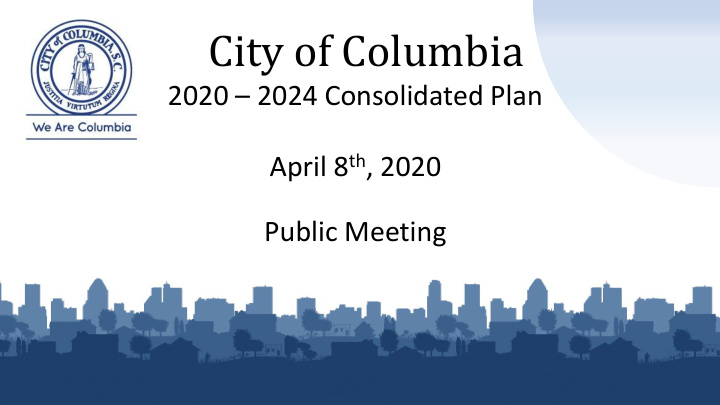



City of Columbia 2020 – 2024 Consolidated Plan April 8 th , 2020 Public Meeting
Consolidated Plan Process/Requirements Consolidated Plan • HUD entitlement grant programs are administered through the Consolidated Plan (ConPlan) o Managed through HUD’s Integrated Disbursement and Information System (IDIS) Online • Helps grantees determine activities and organizations to fund in the coming years. • Describes community needs, resources, priorities, and proposed activities to be undertaken under certain HUD program for the following five years. Annual Action Plan • The Annual Action Plan (AP) is submitted to HUD every year during the five-year ConPlan cycle. • Describes the specific planned uses for HUD programs, and other program requirements.
ConPlan - Five Components HUD 2020 Fund Allocation 1. Needs Assessment Source Amount 2. Housing Market Analysis CDBG $1,040,310 3. 5-Year Strategic Plan HOME $636,992 4. Annual Action Plan 5. Citizen Participation HOPWA $1,517,489 Total $3,194,791
Community Development Block Grant (CDBG) Flexible funding source that can be used for a variety of activities targeted towards low to moderate income individuals, households, and neighborhoods (80% Area Median Income and below). Eligible uses include: • • Public Improvements (Streets, Acquisition of land or real property to Sidewalks, Parks, Sewers, etc.) be used for eligible purposes • • Public Facilities (Neighborhood Economic Development Activities • centers, non-profit centers, Public Services Including: healthcare, • homeless facilities) homeless services, literacy, youth • Rehabilitation of residential and services, senior services • • non-residential buildings Planning and Administration
Home Investment Partnership Program (HOME) Funds non-profit and private developers to create affordable homes for low- and moderate-income people (under 80% of Area Median Income). Possible projects include: -Multi-family apartment buildings -Housing for people with special needs (homeless, developmental disabilities etc.) -First-time Homebuyer assistance -Housing Rehabilitation -Rental Assistance (vouchers) -Capacity building for local community housing development organizations
Housing Opportunities for Persons With AIDS (HOPWA) The HOPWA program provides funding to: • Housing (acquisition; rehabilitation; or new construction of housing units; rental assistance, etc) • Social services • Program planning • Development costs An essential component in providing housing assistance for this targeted special needs population is the coordination and delivery of support services.
Priority Needs & Goals Expand & Improve Public 1A Expand Public Infrastructure Infrastructure & Facilities 1B Improve Public Infrastructure Capacity 1C Improve Access to Public Facilities Preserve & Develop Affordable 2A Increase Homeownership Opportunities Housing 2B Increase Affordable Rental Housing Opportunities 2C Provide Code Enforcement in LMI Neighborhoods 2D Provide Removal of Slum & Blight in Residential 2E Provide for Owner Occupied Housing Rehab Public Services & Quality of Life 3A Provide Supportive Services for Special Needs Improvements 3B Provide Vital Services for LMI Households Housing & Supportive Services 4A Provide Housing Opportunities Persons HIV/AIDS for Persons HIV/AIDS 4B Provide Medical & Support Services HIV/AIDS
Action Plan Projects - CDBG Project Name Funding $208,062 CDBG: Administration (20%) $364,109 CDBG: Public Facilities & Infrastructure $312,093 CDBG: Housing Programs $156,046 CDBG: Public Services (15%) Total CDBG $1,040,310
Action Plan Projects - HOME Project Name Funding HOME: Administration (10%) $63,699 HOME: CHDO Reserves (15%) $95,549 HOME: Owner Occupied Rehab $191,098 HOME: City Lender Program $95,549 HOME: Non-CHDO Development Activities $191,098 Total HOME $636,992
Action Plan Projects - HOPWA Project Name Funding HOPWA: Administration (3%) $45,525 HOPWA: Resource ID $5,000 HOPWA: Columbia PHA $597,825 HOPWA: Palmetto AIDS Life Support $329,553 HOPWA: The Cooperative Ministries $176,371 HOPWA: Upper Savannah Care Consortium $25,000 HOPWA: Midlands Housing Alliance Transitions $21,390 HOPWA: USC Dept. of Medicine $400,797 Total HOPWA (including Prior FY2019 funds) $1,708,477
Citizen Participation – Survey Responses Community Survey Stakeholder Survey (50 responses): (33 community organizations responded): • Public Improvements Creation of affordable housing and homebuyer • Sidewalks assistance. • • Water/Sewer & Stormwater Improvements Public services such as employment training, crime • Street Improvements prevention and vital services for the special needs Economic Development population. • • Small Business Assistance Homeowner and renter housing rehabilitation. • • Public Transportation Public facilities and infrastructure improvements. • • Job Creation & Retention Economic development Affordable Housing • New Affordable Rental & Homeowner Housing • Rental & Owner-Occupied Housing Rehab • Energy Efficient Improvements • Down Payment Assistance *Survey responses as of April 3, 2020
Needs Assessment – City Demographics Table: Demographics – 2010 to 2017 Base Year: 2010 2017 % Change Population 127,605 132,236 4% Households 46,575 46,098 -1% Median Income $38,272 $43,650 14% Table: Population – 2010 to 2017 2010 2017 % Change Columbia 127,605 132,236 4% State of South Carolina 4,511,428 4,893,444 8.5% Table: Housing Costs – 2010 to 2017 2010 2017 % Change Median Home Value $156,100 $168,800 8.1% Median Rent $742 $878 18.3% • Cost burden: • Over 55% of renters pay more than 30% of their income to housing costs. • Over 21% of homeowners are cost burden. Population Change since 2000 Source: 2013-2017 ACS via PolicyMap
Needs Assessment – LMI Areas Table: Poverty Rate – 2000 to 2017 Poverty Rate - Poverty Rate - Change in 2000 2017 Poverty Rate Columbia 22.1% 22.3% +0.2% South Carolina 14.1% 16.6% +2.5% Source: 2000 Decennial Census and 2013-2017 American Community Survey • Poverty Line for family of 4 is $25,100 (2018) Low to Moderate Income (LMI) • LMI = Less than 80% of area median income • Columbia Median income = $43,650 • LMI in Columbia = Less than $34,920 (approx.) Low to Moderate Income Tracts Source: HUD LMISC FY2019
Next Steps • Public comment period (April 3 rd -May 4 th ) • Public hearing (April 8 th ) • City Council approval (April 21 st ) • HUD submission date (May 15 th ) • Program year start date (July 1 st )
Questions or Comments By mail: Community Development Department 1401 Main Street, 4 th Floor Columbia, South Carolina 29201 By Phone: (803) 545-3373 By email: CommunityDevelopment@ColumbiaSC.gov
Recommend
More recommend